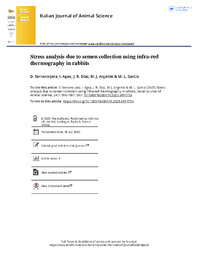Please use this identifier to cite or link to this item:
https://hdl.handle.net/11000/36919Full metadata record
| DC Field | Value | Language |
|---|---|---|
| dc.contributor.author | Serrano Jara, Daniel | - |
| dc.contributor.author | Agea, Iván | - |
| dc.contributor.author | DIAZ SANCHEZ, JOSE RAMON | - |
| dc.contributor.author | Argente, María José | - |
| dc.contributor.author | Garcia Pardo, Maria Luz | - |
| dc.contributor.other | Departamentos de la UMH::Tecnología Agroalimentaria | es_ES |
| dc.date.accessioned | 2025-07-22T06:43:22Z | - |
| dc.date.available | 2025-07-22T06:43:22Z | - |
| dc.date.created | 2025-04-18 | - |
| dc.identifier.citation | Italian Journal of Animal Science 2025, Vol. 24, n.1, 996-1007 | es_ES |
| dc.identifier.issn | 1828-051X | - |
| dc.identifier.uri | https://hdl.handle.net/11000/36919 | - |
| dc.description.abstract | This research evaluated the thermal response to semen collection in rabbits using infra-red thermography in the eyeball, pinna, and nose, alongside measurements from an infra-red fore-head thermometer on the pinna. In the first experiment, 20 rabbits were divided into control and stressed groups. Basal temperatures were recorded at minutes 0, 1, 5, and 10, with semen collected at minute 0 for the stressed group. The stressed group showed a temperature rise in the eyeball at minute 5 (37.80 ºC vs. 37.58 ºC; p 1⁄4 92%), but no in the nose or pinna (p < 90%). The thermometer provided results consistent with IRT for the pinna. In the second experiment, 40 rabbits underwent temperature monitoring over 30 min, with semen collection at minute 0. Rabbits were then divided into single- and double-stressed groups. For the double-stressed group, a second semen collection occurred at minute 30, with measurements until 90 min. Eyeball temperatures rose between minutes 0 and 1 (36.37 ºC–36.61 ºC; p 1⁄4 99%) and stabilised by minute 30 (p 1⁄4 94%). A second reaction to semen collection was observed between minutes 30 and 40 (p 1⁄4 93%), but baseline temperatures were not restored. In the pinna and nose, thermal reactions were identified within the first 15 min (p > 99%) but also failed to stabilise. These findings confirm that semen collection induces stress, with the eyeball providing the fastest and most stable thermal response. Infra-red thermography is a reliable, non-invasive monitoring tool, and infra-red thermometers offer a cost-effective alternative for the pinna | es_ES |
| dc.format | application/pdf | es_ES |
| dc.format.extent | 13 | es_ES |
| dc.language.iso | eng | es_ES |
| dc.publisher | Taylor and Francis | es_ES |
| dc.rights | info:eu-repo/semantics/openAccess | es_ES |
| dc.rights | Attribution-NonCommercial-NoDerivatives 4.0 Internacional | * |
| dc.rights.uri | http://creativecommons.org/licenses/by-nc-nd/4.0/ | * |
| dc.subject | Buck | es_ES |
| dc.subject | Infra-red thermography | es_ES |
| dc.subject | Welfare | es_ES |
| dc.subject | Eyeball | es_ES |
| dc.subject | Semen collection | es_ES |
| dc.title | Stress analysis due to semen collection using infra-red thermography in rabbits | es_ES |
| dc.type | info:eu-repo/semantics/article | es_ES |
| dc.relation.publisherversion | https://doi.org/10.1080/1828051X.2025.2491753 | es_ES |

View/Open:
Stress analysis due to semen collection using infra-red thermography in rabbits.pdf
1,4 MB
Adobe PDF
Share:
.png)
